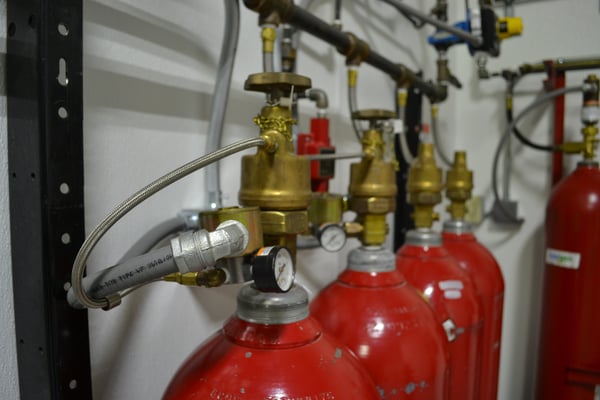
If you have been reviewing potential fire suppressing or extinguishing agents in order to choose the right one for your facility, you may have come across 3M™ Novec™ 1230 Fire Protection Fluid and be wondering what it is.
3M Novec 1230 fluid is a waterless, non-conductive, clean agent fire suppression solution that is stored as a liquid but discharges as a gas.
But with so many clean agents on the market, what makes 3M Novec 1230 fluid different and what potential benefits, or downsides, does it have?
Continue reading to get the answers to these and other questions you may have.
3M Novec 1230’s History & Chemical Composition
In 2004, the 3M Company introduced Novec 1230 fluid as a next-generation halon replacement with a low environmental impact and a high margin of safety. Their goal was to create a compound with such environmental sustainability and safety that it could operate as a long-term solution in the fire protection industry.
Novec 1230 fluid belongs to the chemical family of halocarbons and is a fluorinated ketone with a structural formula of CF3CF2C(O)CF(CF3)2. It neither removes nor reduces oxygen, and it only requires a concentration of 4-6% of the room volume to be effective. The chemical compound also evaporates extraordinarily fast, meaning there is no residue left to be concerned about.
Novec 1230 fluid complies with UL, ULC, and NFPA 2001, the Standard for Fire Extinguishing Systems. It also meets all requirements of the US EPA SNAP Program for toxicity.
The Novec 1230 fluid compound has the largest safety margin for human-occupied spaces with a No Observable Adverse Effect Level (NOAEL) of 10%. It causes zero ozone depletion, less than one global warming potential, and has a very short atmospheric lifetime of 5 days, all of which make it a significant improvement upon previous clean agent chemicals.
How Does it Work?
Novec 1230 fluid is stored as a liquid and super pressurized with nitrogen. An automatic detection system is set to trigger the release of the Novec 1230 fluid when the ignition is in its incipient stage. The gas will discharge within 6-10 seconds of the fire’s detection, going to work before the fire even gets a chance to really start.
Once discharged, Novec 1230 fluid’s chemical composition suppresses the fire by cooling effect which quickly removes the heat, enabling it to extinguish the fire within seconds.
Benefits Over Other Clean Agents
The fact that the composition of Novec 1230 fluid targets the heat element and not the oxygen element of a fire is just one reason why it is a safer agent in human-occupied facilities, along with the very low concentration required to extinguish a fire.
Following are some of the other benefits of Novec 1230 fluid over other clean agents:
- Less than 1 on Global Warming Potential
- Short atmospheric lifetime (only 5 days)
- 0 ozone depletion potential
- Highest safety margin for human-occupied spaces among clean agents
- Less volume of the agent is needed to extinguish a fire which also means less space is needed to store it
Another benefit is that Novec 1230 fluid is not part of the Halon 1301 phaseout or the HFC phasedown programs. Consequently, you won’t have to worry about being required to change agents again anytime soon due to environmental or safety concerns.
Ultimately, you can also have the peace of mind knowing that, in the event of a fire and activation of your fire suppression system, your clean agent will neither cause damages to your equipment nor harm your employees or the environment.
Benefits Over Traditional Fire Suppression Agents
Odds are that if you are investigating clean agents, you already know the numerous benefits and differences they have from traditional fire suppression options. However, here are some of the specific benefits of Novec 1230 fluid over other options like water mist:
- Extinguishes faster than either water mist or inert gas
- Evaporates fifty times as fast as water and leaves less residue than other agents, minimizing downtime
- Safe for use with delicate electronic equipment
- Safe for delicate and sensitive materials such as paper, art, and artifacts
- Requires less space for storage
Potential Applications for Novec 1230 Fluid
Because Novec 1230 fluid’s composition is unique enough to be used on electrical and sensitive equipment and materials, but safe and powerful enough to also protect human life, it can, and is used where technology and sensitive equipment need to be protected, even where human occupants are present.
Common and ideal applications include:
- Medical facilities
- DATA centers
- UPS rooms
- Telecommunication facilities
- Communication rooms
- Museums
- Power generation and transmission facilities
- Gas and oil stations
- Industrial facilities
- Marine vessels
Call Koorsen for All Your Fire Protection Needs
If you are in the process of needing to either find a replacement for your current clean agent or if you are just beginning the process of selecting what agent to use in your fire protection system, the experts at Koorsen are available to help answer your questions.
With over 70 years in the industry, Koorsen prides itself on being at the forefront of fire protection technology and efficiency. Give Koorsen a call with your questions today.


